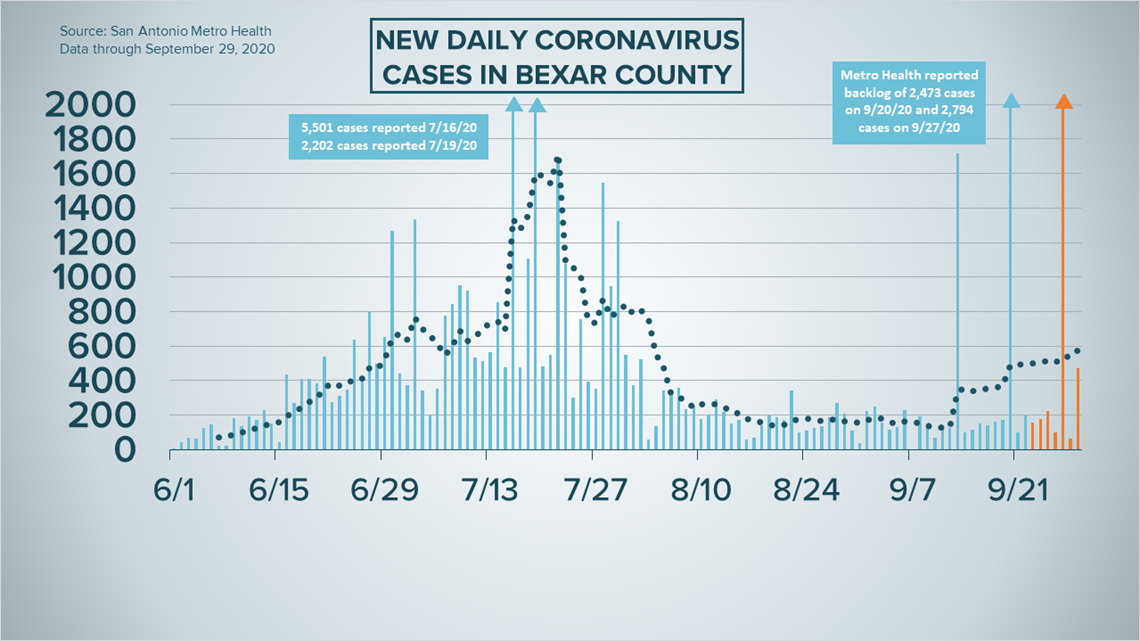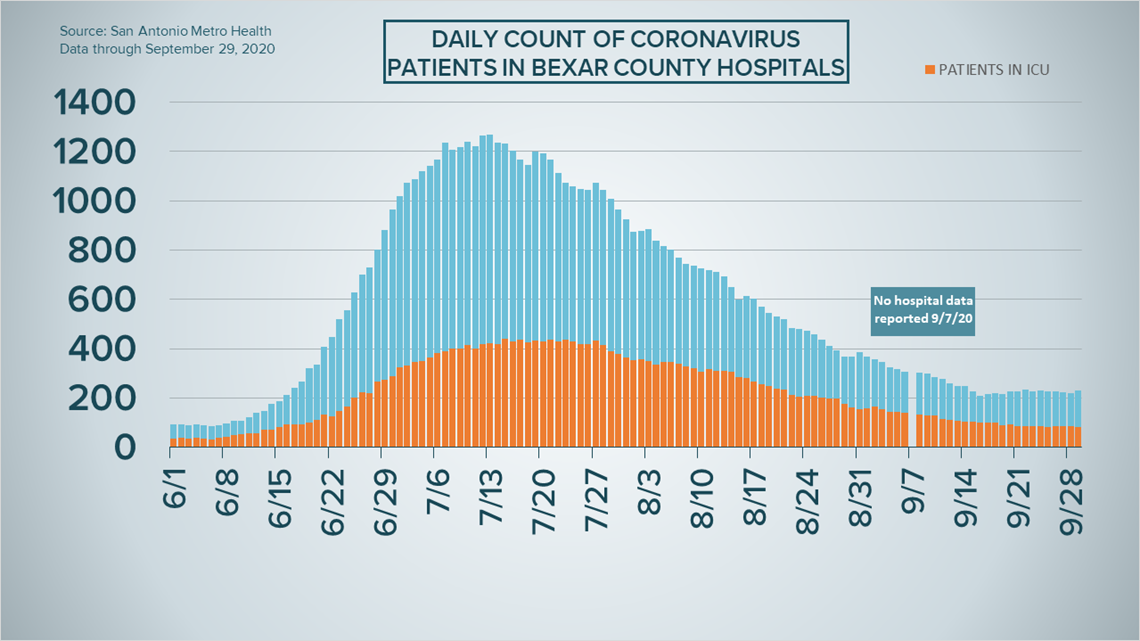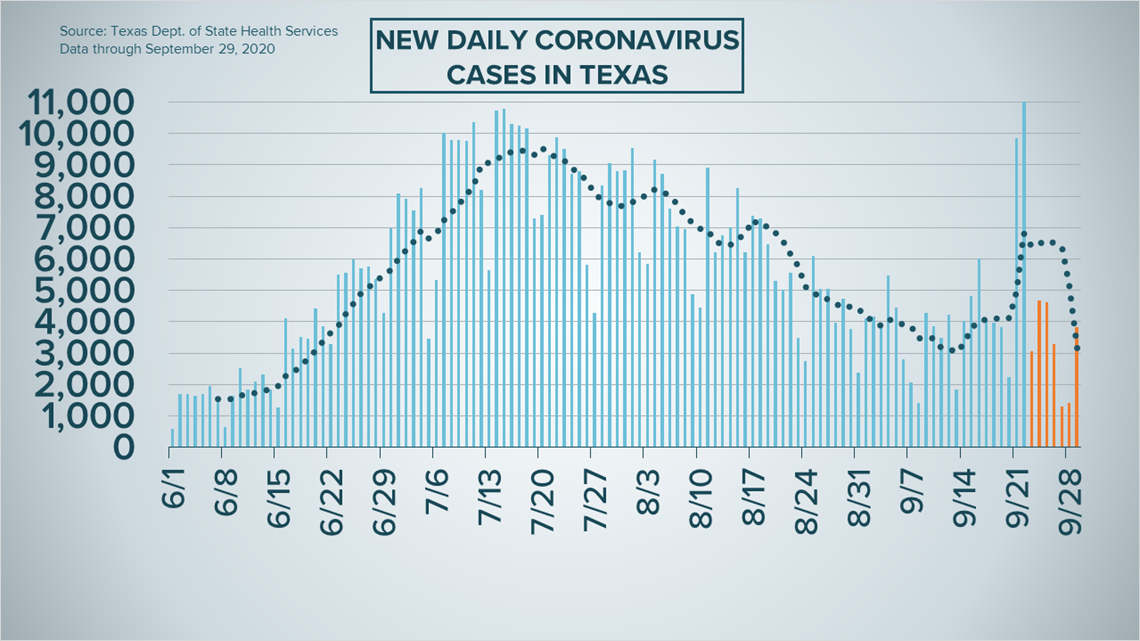SAN ANTONIO — We're tracking the latest numbers from the coronavirus pandemic in San Antonio and across Texas. Here are the latest numbers reported by Bexar and surrounding counties:
- Bexar County: 469 new cases were reported Tuesday, bringing the total number for the county to 57,677. The county death toll rose 1,135 as five new fatalities were reported.
- Comal County: The county reported 35 additional cases on Tuesday, 22 of which were attributed to a backlog. No additional deaths were reported. There have been a total of 3,466 cases of COVID-19 in the county – including 2,744 confirmed cases – while 116 county residents have died. County officials say there are 151 active coronavirus cases, and 3,199 residents are considered recovered.
- Hays County: Officials in Hays County on Tuesday reported 10 new cases in the county and one additional virus-related death. As of Tuesday, there are a total of 5,926 lab-confirmed cases in the county (1,456 of which are active) while the death toll rises to 55. 4,415 residents have recovered from the virus.
How Bexar County is trending
We've tracked how many coronavirus cases have been confirmed in Bexar County from the time officials began reporting cases in March 2020. The graphic below shows the number of cases since June and charts those daily case numbers along a 7-day moving average to provide a more accurate picture of the overall coronavirus case curve in our area and the direction we're trending amid the pandemic.
On Tuesday, San Antonio Mayor Ron Nirenberg reported an additional 469 new coronavirus cases in Bexar County. While that number is noticeably larger than other daily totals in September, the mayor said only 262 are new cases from the past week; the remaining 207 cases stem from a backlog of cases from between Sept. 15 and Sept. 23.
As such, the seven-day moving average of new daily cases for the county rose only slightly on Tuesday, to 178.
Nirenberg also reported an additional five local deaths from coronavirus complications. In all, 1,135 Bexar County residents have died from COVID-19.


Meanwhile, the number of county residents receiving treatment for COVID-19 symptoms rose marginally on Tuesday, to 230. That's a difference of 10 from Monday. The number of patients using ventilators (29) is up from Monday, while the number of patients in ICU (81) is down.


Coronavirus in Texas
The number of Texans who have tested positive for the coronavirus since the pandemic began grew by 3,812 on Tuesday, according to the Texas Department of State Health Services. 250 cases stem from a number of backlogs in several counties:
- 1 older case reported in Collin County.
- 11 older cases reported in Dallas County.
- 13 older cases reported in Galveston County.
- 221 older cases reported in Harris County.
- 4 older cases reported in Nacogdoches County.


State health authorities, meanwhile, reported an additional 71 virus-related deaths on Tuesday. In all, at least 15,604 Texans have passed away from COVID-19 complications.
The state also saw a sharp uptick in current hospitalizations, relative to recent days. There were 50 more Texans receiving treatment for coronavirus symptoms, for a total of 3,251; the last time the number was that high was on Sept. 15.
Latest Coronavirus Headlines
- 'Post COVID-19 syndrome': More than a third of positive patients report lingering symptoms, study says
- Texas State University System to hire contact tracers as experts warn of a fall COVID-19 surge
- Titans report NFL’s first COVID-19 outbreak after game against Vikings, the Texans' next opponent
- Holiday shopping tips during the coronavirus pandemic
- Another $1,200 check in Democrats' scaled-back COVID-19 relief
- Students, parents decide if time is right to head back to school campuses
- Have a cough? How to tell if it is fall allergies or the coronavirus
- US to ship millions of tests in push to reopen K-12 schools
Coronavirus symptoms
The symptoms of coronavirus can be similar to the flu or a bad cold. Symptoms include fever or chills, cough, shortness of breath or difficulty breathing, fatigue, muscle or body aches, headache, new loss of taste or smell sore throat, congestion or runny nose, nausea or vomiting and diarrhea, according to the Centers for Disease Control.
Most healthy people will have mild symptoms. A study of more than 72,000 patients by the Centers for Disease Control in China showed 80 percent of the cases there were mild.
But infections can cause pneumonia, severe acute respiratory syndrome, kidney failure, and even death, according to the World Health Organization. Older people with underlying health conditions are most at risk.
But infections can cause pneumonia, severe acute respiratory syndrome, kidney failure, and even death, according to the World Health Organization. Older people with underlying health conditions are most at risk.
Experts determined there was consistent evidence these conditions increase a person's risk, regardless of age:
- Chronic kidney disease
- COPD (chronic obstructive pulmonary disease)
- Obesity (BMI of 30 or higher)
- Immunocompromised state (weakened immune system) from solid organ transplant
- Serious heart conditions, such as heart failure, coronary artery disease, or cardiomyopathies
- Sickle cell disease
- Type 2 diabetes
The CDC believes symptoms may appear anywhere from two to 14 days after being exposed.
Human coronaviruses are usually spread...
- Between people who are in close contact with one another (within about 6 feet).
- Through respiratory droplets produced when an infected person coughs, sneezes or talks. These droplets can land in the mouths or noses of people who are nearby or possibly be inhaled into the lungs.
- Some recent studies have suggested that COVID-19 may be spread by people who are not showing symptoms.
Help stop the spread of coronavirus
- Stay home when you are sick.
- Eat and sleep separately from your family members
- Use different utensils and dishes
- Cover your cough or sneeze with your arm, not your hand.
- If you use a tissue, throw it in the trash.

